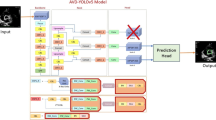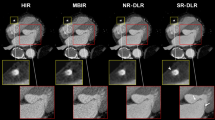Abstract
Objectives
Current coronary CT angiography (CTA) guidelines suggest both end-systolic and mid-diastolic phases of the cardiac cycle can be used for CTA image acquisition. However, whether differences in the phase of the cardiac cycle influence coronary plaque measurements is not known. We aim to explore the potential impact of cardiac phases on quantitative plaque assessment.
Methods
We enrolled 39 consecutive patients (23 male, age 66.2 ± 11.5 years) who underwent CTA with dual-source CT with visually evident coronary atherosclerosis and with good image quality. End-systolic and mid- to late-diastolic phase images were reconstructed from the same CTA scan. Quantitative plaque and stenosis were analyzed in both systolic and diastolic images using artificial intelligence (AI)–enabled plaque analysis software (Autoplaque).
Results
Overall, 186 lesions from 39 patients were analyzed. There were excellent agreement and correlation between systolic and diastolic images for all plaque volume measurements (Lin’s concordance coefficient ranging from 0.97 to 0.99; R ranging from 0.96 to 0.98). There were no substantial intrascan differences per patient between systolic and diastolic phases (p > 0.05 for all) for total (1017.1 ± 712.9 mm3 vs. 1014.7 ± 696.2 mm3), non-calcified (861.5 ± 553.7 mm3 vs. 856.5 ± 528.7 mm3), calcified (155.7 ± 229.3 mm3 vs. 158.2 ± 232.4 mm3), and low-density non-calcified plaque volume (151.4 ± 106.1 mm3 vs. 151.5 ± 101.5 mm3) and diameter stenosis (42.5 ± 18.4% vs 41.3 ± 15.1%).
Conclusion
Excellent agreement and no substantial differences were observed in AI-enabled quantitative plaque measurements on CTA in systolic and diastolic images. Following further validation, standardized plaque measurements can be performed from CTA in systolic or diastolic cardiac phase.
Clinical relevance statement
Quantitative plaque assessment using artificial intelligence–enabled plaque analysis software can provide standardized plaque quantification, regardless of cardiac phase.
Key Points
• The impact of different cardiac phases on coronary plaque measurements is unknown.
• Plaque analysis using artificial intelligence–enabled software on systolic and diastolic CT angiography images shows excellent agreement.
• Quantitative coronary artery plaque assessment can be performed regardless of cardiac phase.




Similar content being viewed by others
Abbreviations
- AI:
-
Artificial intelligence
- BMI:
-
Body mass index
- CAD:
-
Coronary artery disease
- CAD-RADS:
-
Coronary artery disease-reporting and data system
- CP:
-
Calcified plaque
- CT:
-
Computed tomography
- CTA:
-
Computed tomography angiography
- DL:
-
Deep learning
- ECG:
-
Electrocardiogram
- HU:
-
Hounsfield units
- LD-NCP:
-
Low-density non-calcified plaque
- NCP:
-
Non-calcified plaque
References
Leading causes of death, Centers for Disease Control and Prevention (2022) Available via https://www.cdc.gov/nchs/fastats/leading-causes-of-death.htm. Accessed 13 April 2022
Matsumoto H, Watanabe S, Kyo E et al (2019) Standardized volumetric plaque quantification and characterization from coronary CT angiography: a head-to-head comparison with invasive intravascular ultrasound. Eur Radio. https://doi.org/10.1007/s00330-019-06219-3
Lee S-E, Chang H-J, Sung JM et al (2018) Effects of statins on coronary atherosclerotic plaques: The PARADIGM Study. JACC: Cardiovascular Imaging. https://doi.org/10.1016/j.jcmg.2018.04.015
Hell MM, Motwani M, Otaki Y et al (2017) Quantitative global plaque characteristics from coronary computed tomography angiography for the prediction of future cardiac mortality during long-term follow-up. Eur Heart J - Cardiovas Imaging. https://doi.org/10.1093/ehjci/jex183
Lin A, Manral N, McElhinney P et al (2022) Deep learning-enabled coronary CT angiography for plaque and stenosis quantification and cardiac risk prediction: an international multicentre study. Lancet Digital Health. https://doi.org/10.1016/S2589-7500(22)00022-X
Tzolos E, Williams MC, McElhinney P et al (2021) Pericoronary adipose tissue attenuation, low-attenuation plaque burden and 5-year risk of myocardial infarction. Eur Heart J. https://doi.org/10.1093/eurheartj/ehab724.0156
Abbara S, Blanke P, Maroules CD et al (2016) SCCT guidelines for the performance and acquisition of coronary computed tomographic angiography: a report of the Society of Cardiovascular Computed Tomography Guidelines Committee: Endorsed by the North American Society for Cardiovascular Imaging (NASCI). J Cardiovas Comput Tomography. https://doi.org/10.1016/j.jcct.2016.10.002
Weissman NJ, Palacios IF, Weyman AE (1995) Dynamic expansion of the coronary arteries: implications for intravascular ultrasound measurements. Ame Heart J. https://doi.org/10.1016/0002-8703(95)90234-1
Schuhbaeck A, Dey D, Otaki Y et al (2014) Interscan reproducibility of quantitative coronary plaque volume and composition from CT coronary angiography using an automated method. Eur Radiol. https://doi.org/10.1007/s00330-014-3253-3
Dey D, Zamudio MD, Schuhbaeck A et al (2015) Relationship between quantitative adverse plaque features from coronary computed tomography angiography and downstream impaired myocardial flow reserve by 13N-ammonia positron emission tomography. Circulation: Cardiovascular Imaging. https://doi.org/10.1161/CIRCIMAGING.115.003255
Cury RC, Leipsic J, Abbara S et al (2022) CAD-RADS™ 2.0 - 2022 Coronary Artery Disease-Reporting and Data System: an expert consensus document of the Society of Cardiovascular Computed Tomography (SCCT), the American College of Cardiology (ACC), the American College of Radiology (ACR), and the North America Society of Cardiovascular Imaging (NASCI). J Cardiova Comput Tomography. https://doi.org/10.1016/j.jcct.2022.07.002
Matsumoto H, Watanabe S, Kyo E et al (2019) Effect of tube potential and luminal contrast attenuation on atherosclerotic plaque attenuation by coronary CT angiography: in vivo comparison with intravascular ultrasound. J Cardiovasc Comput Tomography. https://doi.org/10.1016/j.jcct.2019.02.004
Takagi H, Leipsic JA, Indraratna P et al (2021) Association of tube voltage with plaque composition on coronary CT angiography: results from PARADIGM Registry. JACC: Cardiovascular Imaging. https://doi.org/10.1016/j.jcmg.2021.07.011
Achenbach S, Boehmer K, Pflederer T et al (2010) Influence of slice thickness and reconstruction kernel on the computed tomographic attenuation of coronary atherosclerotic plaque. J Cardiovas Comput Tomography. https://doi.org/10.1016/j.jcct.2010.01.013
Nakatani S, Yamagishi M, Tamai J et al (1995) Assessment of coronary artery distensibility by intravascular ultrasound. Circulation. https://doi.org/10.1161/01.CIR.91.12.2904
van Zandwijk JK, Tuncay V, Vliegenthart R et al (2020) Assessment of dynamic change of coronary artery geometry and its relationship to coronary artery disease, based on coronary CT angiography. J Digital Imaging. https://doi.org/10.1007/s10278-019-00300-5
Han D, Berman DS, Miller RJH et al (2020) Association of cardiovascular disease risk factor burden with progression of coronary atherosclerosis assessed by serial coronary computed tomographic angiography. JAMA Network Open. https://doi.org/10.1001/jamanetworkopen.2020.11444
Tzolos E, McElhinney P, Williams MC et al (2021) Repeatability of quantitative pericoronary adipose tissue attenuation and coronary plaque burden from coronary CT angiography. J Cardiovas Comput Tomography. https://doi.org/10.1016/j.jcct.2020.03.007
Funding
This work was supported by NIH grants 1R01HL148787-01A1 and 1R01HL151266, and diversity supplement 3R01HL148787-03S1, and in part by the Dr Miriam and Sheldon G. Adelson Medical Research Foundation.
Author information
Authors and Affiliations
Corresponding author
Ethics declarations
Guarantor
The scientific guarantor of this publication is Dr Damini Dey.
Conflict of interest
Piotr Slomka, Daniel Berman, and Damini Dey: Outside this study, these authors received software royalties from Cedars-Sinai Medical Center and have a patent. The remaining co-authors have no conflict of interest.
Statistics and biometry
One of the authors has significant statistical expertise.
Informed consent
Written informed consent was obtained from all subjects (patients) in this study.
Ethical approval
The study was approved by Cedars-Sinai Medical Center Institutional Review Board.
Study subjects or cohorts overlap
No overlap.
Methodology
• retrospective
• observational
• performed at one institution
Additional information
Publisher's Note
Springer Nature remains neutral with regard to jurisdictional claims in published maps and institutional affiliations.
Supplementary Information
Below is the link to the electronic supplementary material.
Rights and permissions
Springer Nature or its licensor (e.g. a society or other partner) holds exclusive rights to this article under a publishing agreement with the author(s) or other rightsholder(s); author self-archiving of the accepted manuscript version of this article is solely governed by the terms of such publishing agreement and applicable law.
About this article
Cite this article
Flores Tomasino, G., Han, D., Pimentel, R. et al. Reproducibility of artificial intelligence–enabled plaque measurements between systolic and diastolic phases from coronary computed tomography angiography. Eur Radiol (2024). https://doi.org/10.1007/s00330-024-10688-6
Received:
Revised:
Accepted:
Published:
DOI: https://doi.org/10.1007/s00330-024-10688-6




